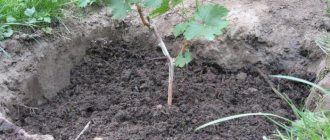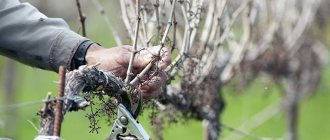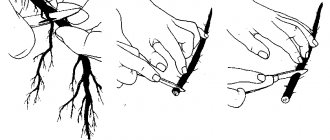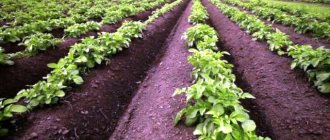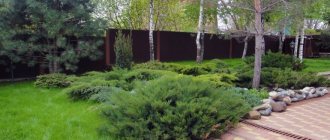If you plan to grow grapes in your country house, get ready for the fact that you will have to work a lot and read a lot. Choosing a variety that is suitable for the climatic conditions of your region is not enough; it is also important to know at what time, in what place, how to plant grapes correctly and how to care for the vine, so that after a couple of years on the shoots, among the foliage, you can find ripe berries with nutmeg taste.
Where to plant grapes on the plot
Grapes are a heat-loving plant; they will not grow in the shade, so when choosing a ridge, special attention should be paid to the southern part of the garden, where the sun warms from morning to evening.
It is this place that the rising sun begins to warm the surface with its rays first. In addition, there should be no drafts on the selected ridge. Due to cold gusts of wind, the grapevine will begin to wither and will soon have to be dug up and disposed of; you should not expect any yield from such a bush. Moderate soil moisture plays a significant role in good vineyard growth. If your summer cottage is located near a pond or lake, then it is better to plant grape cuttings on a small hill, away from the water. Otherwise, the root system may rot due to stagnation of water. Advice! A vine canopy on the south side of the house will take up little space and will decorate the yard area.
Constructions
Very often in summer cottages you can find special structures for vines - trellises. Anyone can make these designs with their own hands without much difficulty. Trellis come in the following varieties:
- single-plane;
- two-plane;
- decorative.
A single-plane trellis allows the plant to grow and develop in one plane. The main advantage of this type of structure is that it is inexpensive and does not require special devices and tools to install the structure.
Two-plane supports can be straight, V-shaped, or Y-shaped. Typically, this type of support structure is used for growing grape varieties with active growth. But please note that this design is used mainly for non-covering varieties.
So, in this article we have brought to your attention several practical tips and recommendations that will allow you to plant grapes in your garden plot and get a good harvest. After all, grapes are a very healthy product, since this berry is a source of vitamins and easily digestible fructose.
Soil preparation
The location for the vineyard has been chosen, now it’s time to prepare the land for new seedlings. Fertile but rocky soil is suitable for berry bushes. In it, the percentage of water stagnation is reduced, and accordingly the level of accumulation of salts and lime will be minimal. Some grape varieties take root better in sandy-clayey soil. Therefore, choose the grape variety for planting based on the composition of the soil on your plot.
Soil preparation begins a month before the expected date of planting the cuttings. First, weeds and debris left over from last year are removed from the beds. After this, each square meter is dug up with 10 kg of manure, which is initially mixed with 150-200 g of wood ash. A couple of days after harrowing, the dug up area is leveled, beds 30-40 cm high and up to 1 m wide are erected. Sides can be built around the bed, they will decorate the area and keep the bed in its original form.
Grape shoots add several centimeters or meters in length every month. In order for the vineyard to curl beautifully upward, metal or wooden trellises are installed for it, which can be purchased at any specialized store or made independently. The support columns are buried in the ground to a depth of at least half a meter and the earth around them is compacted.
Two weeks before planting the cuttings, they begin to prepare the beds. First of all, dig holes up to half a meter deep and wide. The distance between the holes is usually done as follows: a low-growing variety - 3 meters, a vigorous variety - 4 meters. About 3 buckets of gravel, sand or crushed stone are poured into an even layer at the bottom of the dug hole, 2 buckets of humus, half a kilo of superphosphate, 1 kg of ash and a bucket of fertile soil are poured on top.
Choosing a site for a vineyard
Choosing a site for a vineyard
Grapes are a perennial crop. Therefore, the choice of site for a vineyard should be given very serious attention. The longevity of the plantings, the normal development of the bushes, productivity, and the quality of the fruit depend on the correct choice of location.
It is best to plant an amateur vineyard on open, generously sunlit southern and southwestern slopes, protected from the prevailing winds from the north and northeast in the area by buildings, walls, fences, and plantings in adjacent courtyards and plots. Bushes should not be planted close to trees and shrubs, as their roots greatly dry out and impoverish the soil. It is necessary that the distance from them be 3 and 2 m, respectively.
It is also undesirable to plant grapes near manure heaps and pits, as well as places where various garbage is thrown out.
Related article: Lernat - grapes
Near a residential building, in order to avoid settlement of the foundation due to heavy watering, you need to plant grapes no closer than 1.5 liters from the wall, followed by bringing the vines to it by means of catavlak, that is, by layering a bush. In this case, such bushes are watered at the location of the heel roots. In young vineyards that do not yet have protection from northern and north-eastern winds, it should be created by planting currants, fruit or, in extreme cases, ornamental trees. They should be pruned at a height of 2–3 m so as not to shade the neighboring area.
In many collective vineyards of Donbass, amateurs place country houses and fruit trees on the southwestern or western side, and plant grapes on the eastern and northeastern sides. In this case, it bears fruit poorly, especially if the plantings are not irrigated. The prevailing eastern winds dry out the soil and oppress the bushes; at low temperatures in winter, their buds and roots freeze out.
I will give two examples. 15 years ago I planted grapes around a young White apple tree: on the southeast side there were 2 Riesling bushes, and on the southwest side 2 bushes of the Madeleine Angevin variety. Each bush was placed at a distance of 2.5 m from the apple tree. Four years later, the plants began to produce a harvest, but at this time the crown and roots of the apple tree grew and it began to shade the grape bushes. In the sixth year they almost stopped bearing fruit.
I tried to graft and regraft the bushes with other varieties. But this didn’t help much either.
In 1969, the crown of the apple tree had to be partially cut off on the southeast and southwest sides to give the grape bushes more sun. The very next year the plants recovered and resumed bearing fruit. This example clearly demonstrates how grape bushes are affected by the proximity of trees, shading, and lack of light and sun.
Here's another example. At the eastern wall of my house there is a hybrid Black Sweet Wine grape bush. This hybrid is quite frost-resistant and multi-yielding. What do I notice? In years when strong and cold northeastern winds blow in winter, the yield drops to 5–7 kg per bush. With weaker winter winds and temperatures not lower than minus 25°, the yield reaches 22–25 kg.
All this is due to the fact that the house on my personal plot is on the western side and the north-eastern winds that prevail in our winter damage the grape bush that I talked about.
In 1968–1969 Many winegrowers in Donbass have completely lost bushes of frost-resistant grape varieties that were not protected from northeastern winds.
How to choose the right seedling and plant it
In order for a seedling to take root on your site, you first need to choose the variety that you want to grow. If you live in the central zone and want to grow southern grapes, most likely you will succeed, because the climatic conditions and composition of the soil from your summer cottage should be suitable for the plant. Planting material is usually purchased two years old; it takes root better in a new place and will be able to bear fruit within a year or two.
When purchasing cuttings, pay special attention to the appearance of the plant. They should not have visible damage, such as brown spots or deep scratches. Before planting, seedlings for the vineyard are processed by removing damaged roots and upper branches. Only the lower node of the root system is left, all other side shoots are cut off so that they do not interfere when planting seedlings in open ground. Before planting, the seedlings are taken outside and left to lie in a place sheltered from the wind all day. Air procedures last 4-5 days. This hardening will prevent the grapes from dying from hypothermia.
Planting grapes in black soil and clay
A seedling is carefully inserted into the recess with fertilizers and the root system is corrected so that during active growth it does not reach towards the sun, but spreads out to the sides. Fill the hole with fertile soil to a depth of 20 cm, pour 30 liters of water, warmed under the sun's rays, into the hole. Watering is needed to compact the soil and moisten the roots. Half an hour after watering, the remaining soil is poured into the hole. Water the plants again and loosen the soil to a depth of 10 cm. During the week, the procedure with water and loosening is repeated twice. The last time after the agricultural method, the land is mulched. It is better to plant grapes in the ground at sunrise or sunset so that the scorching rays do not damage the plant.
Attention!
Planting a one-year-old plant is done in the same way, only in this case a sealant made from a special material is laid out in a 5-10 cm layer on the bottom of the hole.
Planting grapes in sandy soil
Growing grapevines in sandy soil is much more difficult. The sun's rays quickly warm the sand. However, the heat of the sun does not last long and the sandy surface cools down at night or when weather conditions change. With constant temperature fluctuations, the root system will die, so if your garden soil contains a sandy substance, then be patient and follow our advice:
- Dig a hole, the depth of which should be 1 - 1.2 m.
- Place a 20 cm layer of dense clay at the bottom of the excavation.
- Apply a 25 cm layer of organic fertilizer.
- Plant the seedling at a depth of 50–60 cm.
- Cover the roots with soil.
- Water the plant once a week.
- Pour at least 40 liters of water under each bush.
How to plant grape seedlings during the growing season
Vegetating seedlings are planted in open ground only in spring, at the moment when green leaves appear on young shoots. The bed is prepared in the same way as for annual seedlings. Before planting, the green shoot is watered abundantly, then the polyethylene “pot” is cut and the seedling, along with a lump of earth, is transferred to the prepared hole. The stem with the root system is covered with a layer of soil with fertilizers down to the leaves. The shoot is tied to a peg. During active growth, the two lower leaves are removed and soil is added to the recess.
What to consider when purchasing ready-made seedlings
Since it is not always possible to turn to a friend for a grape cutting, a common way to purchase a seedling is to buy it at the market. But so that the acquisition does not become a source of grief, it is important to take into account some points.
Firstly, varieties of grape seedlings are distinguished, which are determined by the rate of growth, the number and uniformity of distribution of roots around the trunk. All this affects the time during which the plant reaches the required size and begins to bear fruit.
Since making wine involves large-scale cultivation of grapes, in this case they prefer to purchase elite varieties. For those who like to enjoy fresh berries, the first or second plant varieties are suitable.
Moreover, if there are less than two roots on the shoot, and the growth has not formed, this is called substandard. Since such plants have not yet fully formed, you should not purchase them.
Secondly, grapes are distinguished by type:
- new ones, grown within the same climate zone for about 20 years;
- supernovae, recently hatched and tested in different climatic zones over the last 5-8 years;
- zoned or grown by amateurs, but distinguished by good fruiting in their region.
In this case, it is worth paying attention to the area from which the grapes were brought. This is to determine how easily it will tolerate temperature changes in one direction or another. And it will be easier for the owner to preserve the seedlings.
Kerria or Keria: photo and description of the shrub, rules and subtleties of growing a plant with yellow flowers
Ornamental shrubs in landscape design blooming in autumn
Autumn planting of shrubs: useful tips from experienced gardeners
Therefore, before purchasing the cuttings you like, you should pay attention to the following features:
- the presence of a polyethylene box with a drainage layer and wet soil;
- the presence of at least two roots without thickenings or growths;
- a tag indicating the plant variety;
- the presence of at least three blossoming leaves on the trunk;
- the trunk itself must be strong, without mold, growths, stains, or seals;
- at least 6 brown buds.
If at least one of the parameters does not meet the standard, it would be prudent to postpone the purchase or choose another cutting.
When to plant grapes in spring
Spring planting does not have specific dates for planting plants in open ground, because in each region the climatic conditions are different and the degree of warming up of the land largely depends on the location of the dacha. The further south the garden is, the earlier the grapes are planted. The weather will help you avoid mistakes and correctly calculate the landing time. Planting of seedlings is carried out when the air temperature is more than +16 degrees, and the soil temperature is more than +10 degrees, and only after the night frosts have subsided. Based on these criteria, we can conclude that in the south of Russia the optimal temperature regime falls at the end of March, in the middle zone - mid-April or early May, in the northern regions - late May or mid-June.
Pros of spring planting
Grapevines love warmth, so spring planting allows the bushes to get stronger before the onset of cold weather and make it easier to endure harsh climatic conditions in winter. In addition, most varieties planted in spring begin to bear fruit the following year. In the spring it is more convenient to engage in farming, especially for beginning winegrowers, because during the flowering season it is easier to predict the weather and it is easier to decide on the planting day.
Minuses
The most common problem that arises during the period of planting bushes is a lack of moisture for the roots. The plant requires regular watering, especially if the bushes are planted in sandy soil. Also at this time, there is a shortage of grape seedlings in the sales markets. The likelihood of buying a low-quality product for planting increases significantly. It is better to purchase planting material in the fall, when healthy and young shoots with a root system are on the shelves.
Attention!
When buying bushes in the fall, it is not necessary to immediately start planting vines. You can save the seedling until spring by creating suitable conditions for the plant to overwinter.
German and Russian experience in using grapes
It’s beautiful when ornamental shrubs with fragrant flowers, blooming in several stages, such as mock orange and rose, grow on a gazebo or in a mixborder next to the grapes. But immediately choose what is more important to you: grapes or flowers. On a gazebo, for example, they will be intertwined, so it is better to place them at opposite ends. In the garden of one winegrower from Augsburg (Germany) there are many cute and easy to implement design elements - a grape screen near the patio and an inclined pergola above the mixborder.
The combination of warm tones of wood and grape greens is interestingly played out. The mixed border in the wall near the southern wall of the house looks beautiful - young grapes, and roses nearby.
In the Tver village garden of Olena Nepomnyashchaya, next to the guest house in the wall culture, grapes and a climbing rose of the New Dawn . It is very convenient to cover everything at once in the fall. By the way, the rose garden on the southern and western sides can be framed with grape trellises.
Autumn planting
In autumn, grapes are planted after general cleaning of the garden area. The optimal temperature for autumn farming is +15 degrees. In the central zone and to the north, the vegetable garden is harvested until the end of September, so they begin to grow vineyards from the beginning of October. In the south, the last harvest is harvested before mid-October, and grape bushes are planted in late October or early November. Shoots should be planted before the first frost. After planting, the grapes are covered with agricultural material to prevent the seedlings from freezing.
Advantages
In the fall, plants are prepared for sale, so an abundance of healthy and strong bushes of different varieties can be found on the market in the fall. In addition, after harvesting in the garden, the soil is saturated with natural elements and vitamins, which is very important for the growth of new planting material. Over the winter, the seedlings manage to take root, and with the arrival of spring they will immediately begin to grow, bypassing the adaptation period.
Minuses
A sharp decrease in temperature does not have the best effect on the sprouts; sometimes such climatic conditions can destroy the plant. After planting the bushes in open ground, it is imperative that they be covered with a film cover so that the vine is warm in winter. Having planted a vineyard during autumn leaf fall, you should not expect a harvest for the coming year. You will be able to taste the taste of the first berries no earlier than in a couple of years.
Screens – walls of green rooms
An ordinary grape trellis in summer is a screen up to 2 m high and can divide the area into green rooms.
True, after the leaves fall and pruning in the fall, little remains of it. Trellis for screens and walls can be decorative - in the form of a fence, a lattice made of wrought iron or wood. Grapes are planted no closer than 0.8–1 m from the walls of the house. If the climate and topography allow, wine grape varieties in intensive trellis-free culture can be grown very closely: every 0.8–1 m in a row. Several vines (with not the most tempting berries) can be planted along fences.
How to care for a vineyard
In order for the plant to bear a good harvest, you need to take care of it in a timely manner. Likewise, a planted grape bush will quickly die without proper care, and all your efforts will be in vain. The requirements of the bushes are very simple: water, protect from pests and diseases, protect from unfavorable external factors, trim grape shoots and leaves.
Watering and spraying
Shrubs are watered twice a week, provided that rainy weather is rare in summer. At least 10 liters of settled water at room temperature is poured under each bush. After watering, the layer of soil around the vine is loosened and mulched. Spraying the vines with 1% Bordeaux mixture for preventive purposes will prevent the vineyard from becoming infected with fungal diseases. A soap solution prepared from a grated piece of laundry soap and 10 liters of water will help get rid of small pests. In the first two weeks after spring planting, protect the sprouts from direct sunlight.
Top dressing
During planting, a sufficient amount of fertilizer was added to the ground; this feeding of the roots will be enough for 2-3 years. If desired, you can reinforce the bushes at the end of the summer with the following composition: grain acid potassium - 10 g; superphosphate – 20 g. Mix the specified amount of chemical elements in one container and sprinkle the resulting mixture onto 1 square meter. m of land. Thus, the plant is better prepared for wintering.
Trimming
Immediately after planting, trim the vine to 2 eyes. By growing shrubs in this way, you yourself will adjust the desired direction of growth of young shoots. Grapes need to be pruned every year, preferably at the top 3-5 buds. The risk of developing fungal diseases will increase if you do not trim the foliage of the berry bush in a timely manner. In addition, it is much more difficult to spray dense plants, which means that pests will not bypass this vine.
Preparing grape seedlings before planting
Before planting grapes, you must carry out the following steps:
- conduct a visual inspection of the root system: roots that are broken, blackened or have other mechanical damage are removed
- Each root of the seedling is cut by 20-30 mm. This promotes faster development of the root system
- It is advisable to leave the root system in water for a day. Adding stimulants will have a positive effect on the development of the root system
- the remaining leaves should be removed
- immediately before planting, the root system of the grapes is dipped into a mixture of water, clay and ash, in a ratio of 5:3:1.
If any diseases are detected during visual inspection, the seedling must be treated with antifungal drugs.
Immediately before planting a grape seedling, the shoot is pruned so that at least three buds remain.
Reviews
Elizabeth
I tried to plant a grapevine for the first time in the fall, and immediately ran into the problem of where to plant the grapes on the plot. In the end, I chose the sunniest place. After planting the vineyard, the weather quickly turned bad and all the grape shoots froze. In the spring we had to dig up dry bushes and plant new grape varieties instead. This time I was luckier; the grapes took root well over the summer and overwintered quietly. Now bunches of large berries are starting to appear in my garden. The only mistake I made was planting two varieties with different degrees of maturity next to each other. It’s inconvenient to pick berries, but I can boast of a good harvest.
Anna
My neighbors plant grapevines at different times of the year and constantly argue about where to plant the vineyard. As an experiment, I decided to plant grapes both in spring and autumn behind the bathhouse on the sunny side. A year later, spring grapes acquired new shoots earlier than autumn grapes, and the berries of the vine planted in spring appeared earlier. Now I will plant grape bushes only in the spring, because they are much easier to care for and take root faster.
Grape gazebo in the Moscow region
An example of harmony is a grape arbor, entwined with lush foliage, among which here and there, like bright gems, ripe amber or purple clusters delight the eye. This is a great place to nurture a beautiful, but “undisciplined” vine and create shade in a recreation area. Arbor grape culture best meets the biological requirements of a grapevine as a vine, and the yield here can be greater than from trellis plantings. In conditions of limited space, arbor bushes grow upward much more powerfully than trellis bushes. In the north - between Moscow and St. Petersburg - the sunniest and warmest place is chosen for both the vineyard and the grape arbor. During the growing season, the sun is lower than in the south, there is less light and heat, so an open place in the Moscow region or near Tver for grapes corresponds to the conditions of partial shade in southern latitudes.
The simplest type of arbor is four or five flat trellises connected at the top by a wire structure to support the vines and fruits. Both canopy gazebos and gazebos with a roof are popular.
Planting seedlings in a hole
Grafted grape bush, partially covered with soil
Next, we discuss how to plant grape seedlings in holes prepared in advance. You need to plant grapes in the spring at an air temperature of at least +10°C. The weather is preferably cloudy, but this is not critical. The depth of planting seedlings on sandy loam and chernozems is about 50 cm, on rocky soils - 10-15 cm deeper.
Short seedlings with roots are placed vertically in the hole, long ones are placed at an angle. The orientation of the seedling should be as follows: buds to the north, root heel to the south. The roots must be straightened and evenly distributed over the area of the pit.
Often a mound of humus or garden soil is made in the hole. Particular attention should be paid to grafted seedlings. The grafting point should be located above ground level. This is due to the unpleasant possibility of the scion developing its own roots.
They cannot be allowed to appear for two reasons:
- Earlier it was said about the dangers of the upper roots of the vine (excess moisture in summer and freezing in winter)
- The roots of the scion are initially less hardy than those of the rootstock. Therefore, if the root system is “replaced”, that is, the root of the rootstock for some reason loses contact with the scion (dies or separates), then you will get a grape bush with a weak root system, and even located in the upper layers of the soil
In any case, such a newly rooted scion may die after 3-4 years. Therefore, it is better to leave the grafting point above the ground and not fill the hole completely. The fact that the seedling will end up in a kind of depression in the planting hole is not a problem.
Filling the hole is done slowly, gradually covering the roots with soil, adding it in handfuls
Before filling the hole with soil, add a couple of handfuls of barley to it to further stimulate survival.
Each layer of earth is slightly compacted. This is necessary so that no air voids form in the root layer. When the roots are sprinkled to the required level, water the grapes with 5-10 liters of water per bush.
Watering during planting is carried out not using a drainage system (in a plastic pipe), but directly into the ground.
Drip watering of grape bushes during planting
After the water is completely absorbed, usually after 20-30 minutes, additional watering is carried out with the same volume of water.
2-3 hours after watering, loosen the soil. After loosening, the bush needs to be mulched. For this purpose, some organic fertilizer (humus or peat) is used as mulch.
Mulching with straw or sawdust is a compromise, since young seedlings will require a sufficient amount of nutrients, and the use of mineral fertilizers in this case is undesirable, since even their low concentrations can cause burns to the roots.
To protect against diseases, copper-containing preparations of reduced concentration are used for preventive purposes. They spray the top layer of soil.
Usually, the planting scheme does not play a special role, but if dioecious varieties are planted, it is recommended to alternate plants with functionally female flowers with bisexual plants blooming at the same time.
In the first year, you don’t have to install trellises near the bushes, limiting yourself to just ordinary pegs, but since the growth rates of the vines are quite high, it is recommended to install stationary supports already in the second year.
